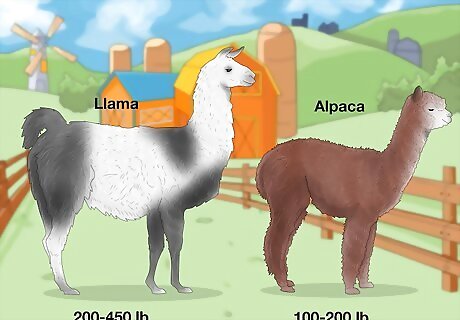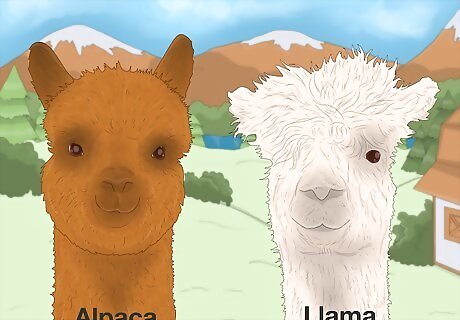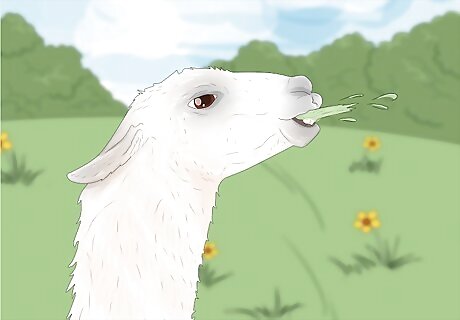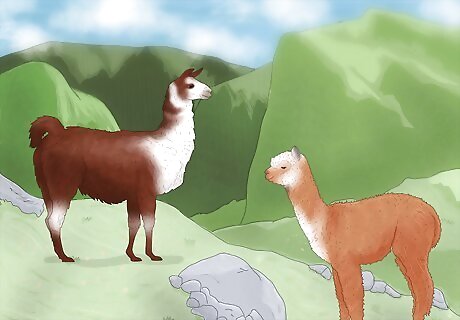
views
- Llamas and alpacas are cousins from the same Camelidae family.
- Llamas are larger than alpacas, outweighing them by about 100 lb (45 kg).
- Alpacas have shorter and stubbier faces and ears than llamas.
Are llamas and alpacas the same thing?

Llamas and alpacas come from the same family but aren't the same animal. There’s a reason llamas and alpacas look so similar. They’re both a part of the Camelidae family and lamoid species. This, however, doesn’t mean they’re the same animal. Llamas and alpacas have many similarities, but they also have a lot of differences. Think of llamas and alpacas as cousins. They’re part of the same family and distantly related.
Differences Between Llamas & Alpacas

SizeAmongst the two, alpacas are generally smaller. They are around 100 to 200 lb (45 to 91 kg) and 47 to 85 in (1.2 to 2.2 m) tall. Llamas, on the other hand, weigh 200 to 450 lb (91 to 204 kg) and are 60 to 72 in (1.5 to 1.8 m) tall.

HairAlpacas have the best wool for fleece production. Their shaggy and somewhat matted locks are perfect for making soft fabrics, whereas the llama’s coarser hair isn’t ideal for trade. A llama’s lightweight wool can be used by weavers and spinners to make thin threads and fabrics.

Face & EarsLlamas have longer faces and ears than alpacas. One of the easiest ways to tell these animals apart is by their face shapes. A llama has a long snout and banana-sized ears, while an alpaca has a stubbier face with short ears.

ColorBoth llamas and alpacas have a variety of color patterns. Llamas can be solid, spotted, or even patterned like a tuxedo in gray, beige, brown, and red. Alpacas have over 22 color combinations, including various whites, blacks, browns, and grays.

PersonalityLlamas and alpacas are both sociable animals, but llamas tend to be more independent. These animals like to be with other animals of their species. However, alpacas gravitate towards herds more easily than llamas due to their skittish nature. They’re also both gentle, intelligent, and curious animals that communicate vocally and with body language. Because of their independence, llamas are often used as guard animals to protect herds of alpacas, sheep, and other livestock. During breeding, a male llama will make an ogling sound to attract a mate. Alpacas and llamas only spit on people when they feel threatened, but they will spit on each other if they’re annoyed.

PurposeIn South American, llamas and alpacas are domesticated animals bred and raised for wool production; however, llamas are generally raised to be pack animals to protect herds and pull carts. In Peru, alpacas can be bred for meat, but it’s more common for llamas to be harvested for meat and hide.
Can alpacas and llamas breed?

Believe it or not, llamas and alpacas can breed to make a llapaca. Despite being two different animals, llamas and alpacas can interbreed and create fertile offspring. When a female llama and male alpaca breed, their offspring or cria is called a llapaca, a hybrid of the two animals. Llapacas generally have smaller frames and heavier fleece.
Where can you meet a llama or alpaca?

Head to your local zoo or wildlife conservatory to meet a llama or alpaca. The easiest way to see a llama or alpaca up close is to visit a zoo or wildlife conservatory. Simply go to your local zoo’s website to see if they have a llama or alpaca exhibit, or search “llama and alpacas near me” online.

Llamas and alpacas are native to South America. These fluffy, long-necked creatures come from the Andes Mountains in South America and can be found grazing along the hilly pastures. While you can find them in the mountains in the wild, they also wander the streets of South America, pulling carts and helping their owners transport goods.



















Comments
0 comment